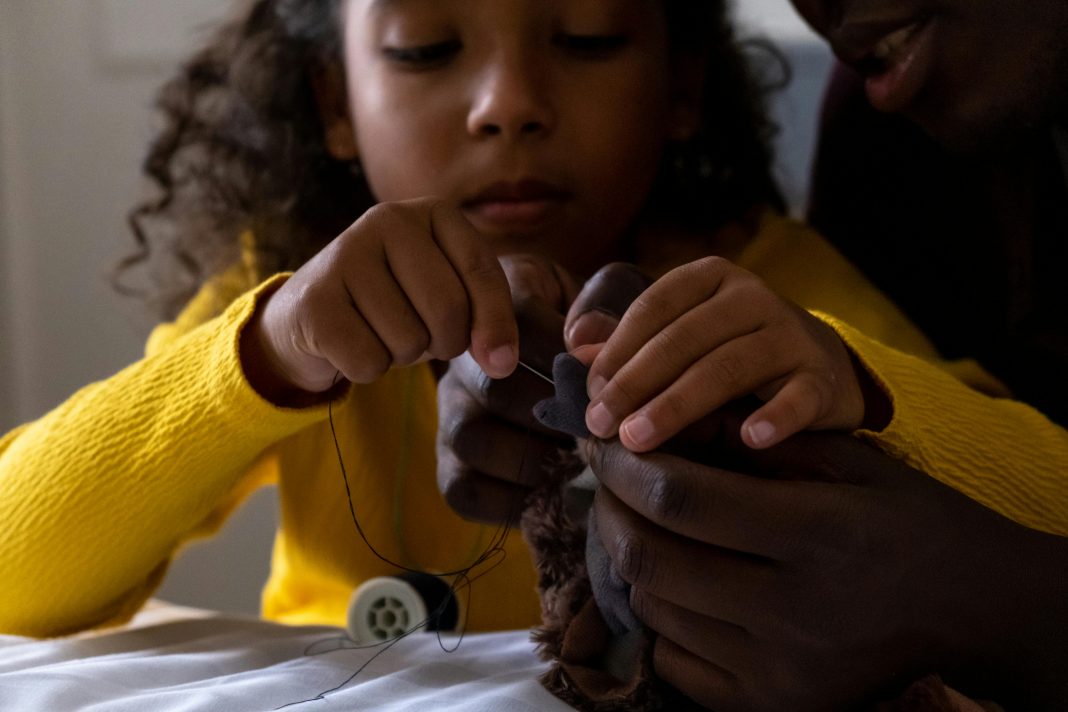Sewing helps kids be creative and teaches them patience and discipline. When you show kids how to sew, it can make them feel good about what they can do, and they’ll have a good time, too. Linen fabric works great for beginners because it’s tough and easy to work with. We’ll talk about why it’s good to teach kids to sew and how to make it fun, as well as some easy projects they can start with.
Flax production makes linen fabric, which is a great pick for kids starting to sew for several reasons:
- Easy to work with Linen fabric has a natural stiffness due to flax fiber, making it simpler for newcomers to handle and sew. It doesn’t slide or stretch as much as other fabrics, letting kids focus on learning without getting frustrated by challenging materials.
- Tough and forgiving: Linen is a strong fabric that can handle multiple sewing attempts, making it perfect for practicing with. Mistakes are less likely to harm the fabric, and removing stitches and sewing again if needed is simpler.
- Natural and breathable: Linen is produced from flax fibers from a flax plant, which makes it a comfy fabric for clothes and other projects. It breathes well and feels soft, so linen products are nice to wear or use in cold as well as hot weather.
- Sparks creativity: Linen has different weights and textures, which allows kids to try various sewing methods, from basic straight stitches to more complex patterns.
- Teaches new things: When kids use linen, they learn about natural fibers and materials that don’t harm the earth, like cotton and wool. This helps them appreciate eco-friendly and biodegradable garment choices in their creative work.
The benefits of teaching kids to sew
Sewing goes beyond being a practical skill; it has many upsides for kids. Firstly, sewing helps kids get better at using their hands. When they thread needles, cut fabric, and stitch, they need to be precise and controlled, which can boost how well their hands and eyes work together.
Also, sewing lets kids be creative. They can show who they are through the colors, patterns, and designs they pick. This chance to create things is helpful when kids often spend more time looking at screens than doing things with their hands.
Sewing techniques help kids learn patience and how to solve problems. Projects don’t always work out the first time, and children discover how to keep going when they make mistakes. This builds their ability to bounce back and think. Also, when kids finish a sewing project, it gives them a sense of pride and makes them feel more confident as they see the garments they made with their hands.
Tips to introduce kids to sewing
Starting with suitable materials and machines plays a significant role in ensuring kids have a good experience with sewing. Linen fabric is an excellent option for beginners because it’s easy to work with, doesn’t fall apart at the edges, and stays in good shape for a long time. Natural linen fibers are soft but firm, making it perfect for children just starting to learn how to sew.
Start with easy, small projects. Don’t scare kids with hard patterns or methods right off the bat. Begin with something doable, like a linen fabric pillowcase, bed sheets, small tote bag, or hand-sewn bookmark. These projects are simple and let kids practice basic stitches while making something they can use or give to others, like bath towels or dish towels.
Another suggestion is to turn sewing into a team effort for a good time. Allow kids to pick their fabric, colors, and designs. Giving them creative control makes the process more fun and helps them feel proud of their work. Also, use bright, big-eye needles and thick thread, which little hands can handle better.
To maintain their engagement, keep sewing sessions brief and fun. Kids can’t focus for long, so it’s better to have regular quick sessions instead of lengthy ones. Compliment their work and recognize small wins to boost their motivation.
Easy sewing projects for kids
After your child gets the hang of the basics, you can show them more advanced projects. Here are some ideas that use linen fabric:
- Linen tote bag: A linen tote bag makes a great starter project. The tough fabric ensures the bag lasts, and its straight lines make sewing easy. Kids can make their bags one-of-a-kind with fabric paint or patches.
- Stuffed animals: Making a simple stuffed animal allows kids to practice stitching and end up with a toy they can take pride in or a simple gift to give to loved ones. Linen fabric works well for this project because it feels soft but very durable and holds up well, which suits items that are handled a lot, like stuffed animals, shirts, skirts, or jackets.
- Linen apron: Linen aprons and napkins are helpful for children who like to help in the kitchen. The fabric breathes and absorbs moisture, making it comfy to wear. Children can customize the aprons by adding pockets or other decorations.
- Simple pillowcases: Pillowcases are a typical project for beginners. Sewing a linen hypoallergenic pillowcase teaches children basic skills such as measuring, cutting, and sewing straight lines. They also see their creation each night, which can boost their self-esteem.
Getting kids started with sewing helps them learn valuable life skills and lets their imaginations run wild. Linen fabric works great for beginners because it’s tough and easy to handle, which makes learning embroidery more fun and less frustrating. When you start with easy projects and let kids get creative, sewing can become a hobby they’ll love for years.
Have you ever shown your children how to sew? What kinds of projects did they like best? Tell us about your experiences and share any tips in the comments — we’d love to hear what you think!





















